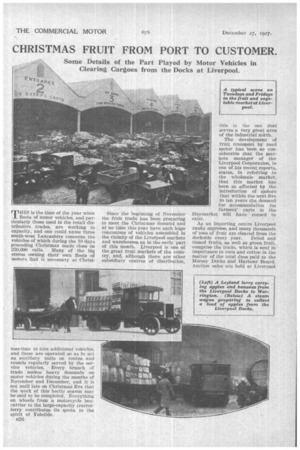CHRISTMAS FRUIT FROM PORT TO CUSTOMER.
Page 40

Page 41

If you've noticed an error in this article please click here to report it so we can fix it.
Some Details of the Part Played by Motor Vehicles in Clearing Cargoes from the Docks at Liverpool.
THIS is the time of the year when fleets of motor vehicles, and particularly those used in the retail distributive trades, are working to capacity, and one could name three south-west Lancashire concerns the vehicles of which during the 10 days preceding Christmas made close on 250,000 calls. Many of the big stores owning their own fleets of motors find it necessary at Christ mas-time to hire additional vehicles, and these are operated so as to act as auxiliary units on routes and' rounds regularly served by the service vehicles. Every branch of trade makes heavy demands on motor vehicles during the months of November and December, and it is not until late on Christmas Eve that the work of this hectic season may be said to be completed. Everything on wheels from a motorcycle boxcarrier to the large-capacity tractorlorry contributes its quota to the spirit of Yuletide.
n26 Since the beginning of November the fruit trade has been preparing to meet the Christmas demand and at no time this year have such huge concourses of vehicles assembled in the vicinity of the Liverpool markets and warehouses as in the early part of this month. Liverpool is one of the great fruit markets of the country, and, although there are other subsidiary centres of distribution, this is the one that serves a very great area of the industrial north.
The development of fruit transport by road motor has been so considerable that the markets manager of the Liverpool Corporation, in one of his recent reports, states, in referring to the wholesale market, that this market has been so affected by the introduction of motors that within the neit•five to ten years the demand for accommodation for farmers' carts in the Haymarket will have • ceased to exist.
As au importing centre Liverpool ranks supreme, and many thousands of tons of fruit are cleared from the dockside every year. Dried and tinned fruits, as well as green fruit, comprise the trade, which is next hi importance to corn and cotton in the matter of the total dues paid to the Mersey Docks and Harbour Board. Auction salt* are held at Liverpool three times a week, and the sales, which are concerned with oranges, lemons, apples, pears, grapes, etc., are 'conducted with such expedition that delivery within an area of 40 miles can take place on the same day and often within a few hours of the discharge of the fruit from the Ship.
Whereas inland wholesale fruit buyers generally prefer the 4-ton lorry for carrying supplies from the warehouses and docks at Liverpool. to the retail shops and for delivering bulk supplies to a series of local re; tail shops, the majority of the small shopkeepers, and especially the who have a brisk trade, prefer their own 30-cwt. vans, so as to achieve a saving in the costs of hired transport between the market and the shop.
Although imported fruit is cleared from the ship's side by heavy motors, It is at the wholesale market 'that big consignments are divided between the retailers, on whom devolves the cost of and responsibility for safe delivery. As purchases may be made by the retailer from as many as half-a-dozen wholesalers,
delay in the loading up of supplies is unavoidable. The fresh-fruit trade is active in the early hours and by 0 a.m. the principal market business of the day is completed. As a general rule, by 10.30 each morning-every shop has its quota of fresh supplies. Apples are packed in cases and barrels, oranges and bananas in crates, tomatoes in cases, grapes in barrels, vegetables more often than not are loose, but in some in-stances are bagged. Consequently, when vehicles start on their journeys their freight is often miscellaneous.
It is noticeable that the Majority of the multiple-shop owner S do not make much use of the light lorry of about 30-cwt. capacity, and the explanation Of , this is that one large
• capacity lorry, by being able to carry a load equivalent to that of.' three yam, may, be kept at work during the Whole of the day delivering supplies to retail premises and at a lower cost. Recognizing that there is not the range of flexibility which a fleet of smaller units would ensure, the bulk traffic is sufficient to enable satisfactory coatings to be realized.' Greengrocers in a_ smaller' way of business find it useful to employ the van for the first journey of the day on really urgent supplies required at the shops. After these haVe been cleared, the second journey may I” made with Produce of secondary importance and the third and subsequent journeys with replenishments and deliveries according to the exi-, gencies of trade. Farmers in southwest Lancashire who are potato growers deliver, direct to shops in the district, using for the purpose
horse-drawn sided lorries. .
• The canned-fruit trade is one of -comparatively recent growth, and forms, in the main, a branch of business independent of the fresh-fruit industry. Some of the Liverpool importers of canned fruit operate large fleets of vehicles, mainly of the light type, for direct deliveries to shdpkeepers, but for wholesale orders to the leading grocery firms delivery is often undertaken by the buyer. The channels through which canned fruit reaches the public are mainly those of the retail grocery trade, which, as is well lmown, is now amongst the largest employers Of commercial motor vehicles in the country.


























































































